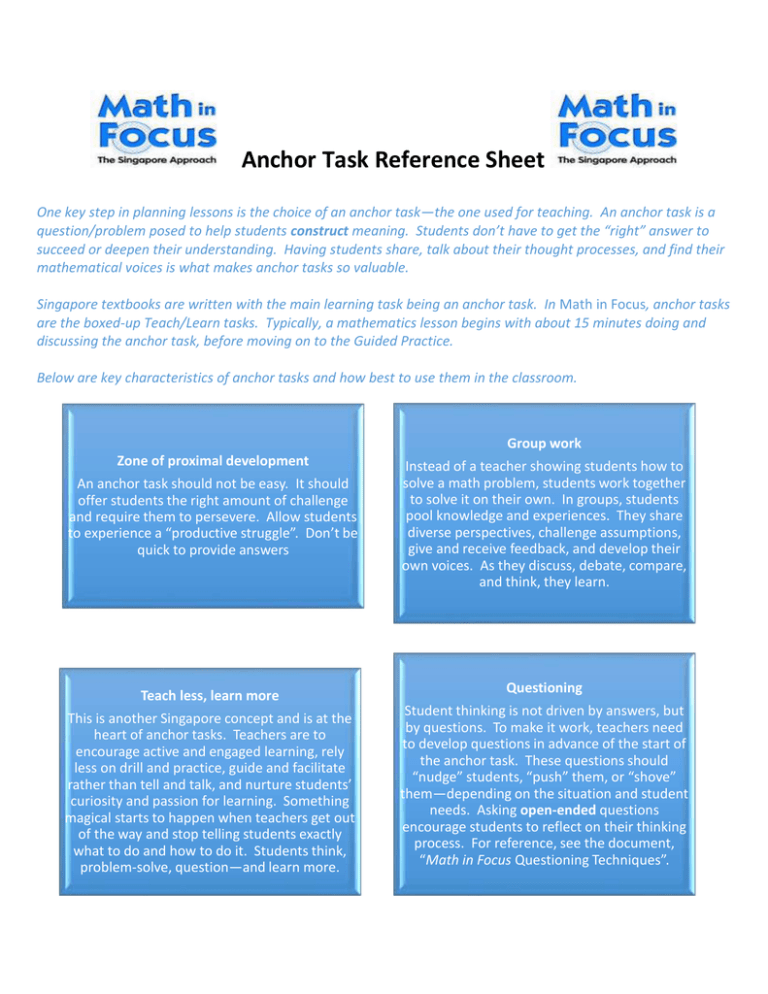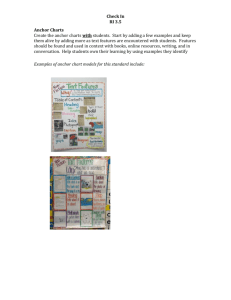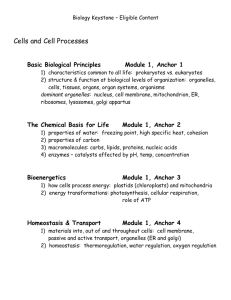Anchor Task Reference Sheet
advertisement

Anchor Task Reference Sheet One key step in planning lessons is the choice of an anchor task—the one used for teaching. An anchor task is a question/problem posed to help students construct meaning. Students don’t have to get the “right” answer to succeed or deepen their understanding. Having students share, talk about their thought processes, and find their mathematical voices is what makes anchor tasks so valuable. Singapore textbooks are written with the main learning task being an anchor task. In Math in Focus, anchor tasks are the boxed-up Teach/Learn tasks. Typically, a mathematics lesson begins with about 15 minutes doing and discussing the anchor task, before moving on to the Guided Practice. Below are key characteristics of anchor tasks and how best to use them in the classroom. Group work Zone of proximal development An anchor task should not be easy. It should offer students the right amount of challenge and require them to persevere. Allow students to experience a “productive struggle”. Don’t be quick to provide answers Teach less, learn more This is another Singapore concept and is at the heart of anchor tasks. Teachers are to encourage active and engaged learning, rely less on drill and practice, guide and facilitate rather than tell and talk, and nurture students’ curiosity and passion for learning. Something magical starts to happen when teachers get out of the way and stop telling students exactly what to do and how to do it. Students think, problem-solve, question—and learn more. Instead of a teacher showing students how to solve a math problem, students work together to solve it on their own. In groups, students pool knowledge and experiences. They share diverse perspectives, challenge assumptions, give and receive feedback, and develop their own voices. As they discuss, debate, compare, and think, they learn. Questioning Student thinking is not driven by answers, but by questions. To make it work, teachers need to develop questions in advance of the start of the anchor task. These questions should “nudge” students, “push” them, or “shove” them—depending on the situation and student needs. Asking open-ended questions encourage students to reflect on their thinking process. For reference, see the document, “Math in Focus Questioning Techniques”. Planning Determine the mathematical objective for the lesson. What are students supposed to learn? Create a task. Teachers can draw on a variety of resources, including textbooks (in Math in Focus, see the Teach/Learn box for the lesson), colleagues, and real-world contexts. The task needs to be a launching pad to the mathematical objective of the lesson. Anticipate what students might do and the hurdles they may face and plan questions to use to “nudge”, “push” or “shove” them. • Use questions that deepen students’ understanding • What math do you want them to learn? • What connections do you want them to make? • What will lead students to more efficient strategies? • What errors do you need to address? • How can students represent/organize their work? Identify and provide appropriate tools and resources for students to choose from. Determine how and when students will work independently and in groups. Plan different ways the task may be approached by students who are progressing at different levels. Decide the format students will record and present their work. Three Elements of a Task Launch Present the problem in a way that pulls students in. Think about a context that is relevant and interesting. Students are encouraged to listen and ask questions to demonstrate understanding of and engagement with the task. Explore Debrief Students work in pairs or small groups while teachers monitor and assess student progress. This is where students construct their understanding. Ask students to justify what they are doing. The class is brought together for students to explain their thinking and their approaches. These student presentations allow teachers to determine what learning has taken place and address any misconceptions. Sequence student presentations with the most basic method being presented first and each successive presentation increasing in complexity.






